
Albania facts & history
in brief
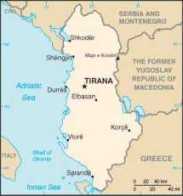
Map of Albania
Tirana
Excerpted from Wikipedia, the free encyclopedia.
Tirana (Albanian: Tiranë or Tirana) is the capital
and largest city of Albania.
Its population is estimated officially at 353,400 in
2003, though other estimates put the figure as high
as 700,000.
Founded in 1614, it became Albania's capital city in
1920.
It is located at 41.33°N, 19.82°E in the district and
county with the same name.
Average altitude is 90 meters above sea level.
The temperature varies between 6.7°C (44.0 °F) in January
and 23.8°C (74.5 °F) in July.
Annual rainfall is 1200 mm (47 inches); the driest months
are July and August.
Located on the Ishm River, Tirana is Albania's chief
industrial and cultural centre.
The principal industries include agricultural products
and machinery, textiles, pharmaceuticals and metal products.
Tirana has experienced rapid growth and established
many new industries since the 1920s.
Tirana is presently trying to develop a tourist industry,
although this effort is hampered by the political instability
in the region, owing to military conflicts during the
1990s in Albania and neighboring Bosnia-Herzegovina,
Kosovo and the Republic of Macedonia.
The Et'hem Bey Mosque, which was begun in 1789
by Molla Bey and finished in 1821 by his son,
Haxhi Et'hem Bey, great-grandson of Sulejman
Pasha is a significant landmark.
Another landmark located near the Ethem Bey
mosque in Skanderbeg Square is the clock
tower (Kulla e Sahatit) which was built in 1830.
In 2001, the construction was finished
on the biggest church of Tirana,
Catholic Church of Saint Paul.
Tirana also features the University of
Tirana, founded in 1957, and many governmental
and social buildings such as the Albanian
Institute of Sciences, the Academy of Arts,
the Agricultural University, the Military
Academy, the Institute of the Ministry of
Internal Affairs, the People's
Assembly, and the High Court.
History
Tirana was founded in 1614 by the Ottoman
general Sulejman Pasha, who built a mosque,
a bakery and a Turkish sauna, and named it
"Tehran", as a tribute to his military
victory at Tehran in Persia (now Iran).
Although this is controversial as there
was prior mentions of a castle in Mount
Dajti called Tirkan by a sixth
century Byzantine Historian.
Tirkan is said to have been there
since the first century BC.
Another mention of the area was found
in Venetian records, which showed the
area under the same name as the city today.
The mention is dated around 1412.
The small town was selected as the temporary
capital of Albania (as a compromise between
South and North Albania) by the provisional
government established at the
Congress of Lushnjë (January 1920).
In November 1944 the communist government
of Enver Hoxha was established there after
the liberation of the city from German
occupation on November 17, 1944.
The city's population, estimated at only
12,000 in 1910, rose to 30,000 at the 1930
census and 60,000 in 1945 despite the
intervening years of foreign occupation and war.
During the 1950s Tirana experienced a period
of rapid industrial growth, raising the
population to 137,000 in 1960.
In the late 1990s Tirana experienced its
fastest population upsurge as Albanians
from the north moved to the capital
in hopes of a better life.
Currently, the city suffers from the
problems of overpopulation such as
waste management, lack of running water
and electricity as well as extremely
high levels of pollution from the
300 000 cars moving in the city.
The problem is exacerbated
by an aging infrastructure.
Despite the problems, Tirana has also
experienced a very rapid growth in
the construction of new buildings,
especially in the suburbs of Tirana,
where many of the new neighbourhoods
do not have yet street names.
During the recent years pollution has
also become a very big problem for
Tirana.
It is worth mentioning that there
is a unique trait to the city, that
effectively moderates the
impact of air pollution: The Saint
Prokopi park- a very vast forested park
in the outskirts of the city, that
absorbs and purifies much of the polluted air.
During the late 1980s and early 1990s
Tirana was the focal point of violent
demonstrations which ultimately led
to the collapse of the communist government.
External links

This page was retrieved and condensed from
(http://en.wikipedia.org/wiki/Tirana) July
2005
All text is available under the terms of the GNU Free
Documentation License (see Copyrights for details).

Unfortunately I do not have many of my photos left,
although we had four cameras between us and we taken
many, many photos wherever we went, two of my cameras,
with large, 512 MB SD Cards and many thousands of photos
on them with my valet and money, were stolen from my
bag, later into our trip, by some 'lowlife'.

You can click on
these photos for an enlargement
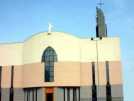 |
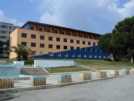 |
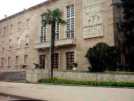 |
| Tirana |
Tirana |
Tirana |
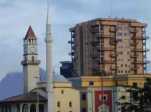 |
 |
 |
| Tirana |
Tirana |
Tirana |

Site
Index
Back to Top
Photos Index
Thanks for coming, I hope you
have enjoyed it, will recommend
it to your friends, and will come
back later to see my site developing
and expanding.
I'm trying to make my pages
enjoyable and trouble free for everyone,
please let me know of any mistakes
or trouble with links, so I can
fix any problem as soon as possible.
These pages are best viewed with monitor
resolution set at 640x480 and kept simple
on purpose so everyone can enjoy them
across all media and platforms.
Thank you.
You can e-mail me at
Webmaster

|